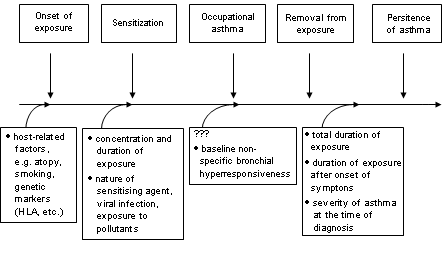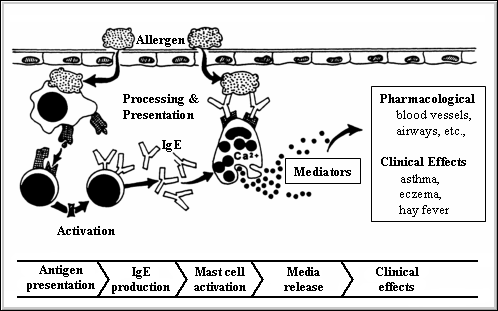 |
| |
| Module 4: Occupational Allergy - Lecture |
1. DEFINITION: OCCUPATIONAL ALLERGY:
- Diseases resulting from a hypersensitivity (exaggerated response) of the immune system to substances encountered in the work environment.
- Constitute 15% of all occupational diseases (Finland)
- Features:
- initial contact with antigen;
- latent sensitisation period of weeks to years between first exposure and development of symptoms;
- temporal symptoms on exposure to very low doses of allergen;
- (exposure to non-specific irritants may trigger a reaction).
2. ALLERGENS:
These are proteins (animal, plant, microbial), enzymes (synthetic), chemicals, spices. These proteins are usually of high molecular weight and cross-react.
3. ROUTES OF EXPOSURE:
- airborne;
- dermal contact;
- (possible) ocular;
- ingestion (cross-reactivity).
4. FACTORS INFLUENCING MANIFESTATION OF ALLERGIC DISEASES:
- dose, duration and route of exposure;
- physical and chemical properties of agent;
- allergenic potency;
- industrial hygiene and engineering practices;
- host factors: atopy, smoking, non-specific bronchial hyper-responsiveness, HLA type.
The diagram below depicts the natural history of an allergic disease such as occupational asthma, illustrating the contribution of these various factors.

5. IMMUNOLOGICAL MECHANISMS:
Coombs and Gell defined four types of immune hypersensitivity reactions:
- Type I - immediate hypersensitivity reaction (IgE-mediated release of inflammatory mediators such histamine) (Figure below) e.g. flour dust causing asthma among bakery workers.

- Type II - cytotoxic reactions (IgG or IgM antibodies against cellular/tissue antigens) e.g. trimellitic anhydride (TMA) causing pulmonary disease anemia syndrome among chemical workers.
- Type III - immune complexes reaction (circulating Ag/Ab complex deposition in capillaries and activating the complement cascade) e.g. pigeon droppings causing extrinsic allergic alveolitis among pigeon breeders.
- Type IV - delayed cell mediated reaction (cytotoxic T cells activation): e.g chrome in cement causing allergic contact dermatitis among builders.




Postgraduate Diploma in Occupational Health (DOH) - Modules 3 – 5: Occupational Medicine & Toxicology by Prof Rodney Ehrlich & Prof Mohamed Jeebhay is licensed under a Creative Commons Attribution-NonCommercial-ShareAlike 3.0 Unported License.
Permissions beyond the scope of this license may be available at http://www.healthedu.uct.ac.za/




